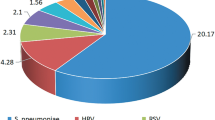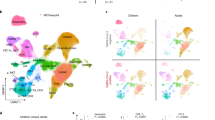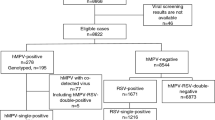Abstract
Background:
It is unknown why human metapneumovirus (HMPV) and respiratory syncytial virus (RSV) cause severe respiratory infection in children, particularly in premature infants. Our aim was to investigate if there are defective airway antiviral responses to these viruses in young children with history of prematurity.
Methods:
Nasal airway secretions were collected from 140 children ≤3 y old without detectable virus (n = 80) or with PCR-confirmed HMPV or RSV infection (n = 60). Nasal protein levels of IFNγ, CCL5/RANTES, IL-10, IL-4, and IL-17 were determined using a multiplex magnetic bead immunoassay.
Results:
Full-term children with HMPV and RSV infection had increased levels of nasal airway IFNγ, CCL5, and IL-10 along with an elevation in Th1 (IFNγ)/Th2 (IL-4) ratios, which is expected during antiviral responses. In contrast, HMPV-infected premature children (< 32 wk gestation) did not exhibit increased Th1/Th2 ratios or elevated nasal airway secretion of IFNγ, CCL5, and IL-10 relative to uninfected controls.
Conclusion:
Our study is the first to demonstrate that premature infants have defective IFNγ, CCL5/RANTES, and IL-10 airway responses during HMPV infection and provides novel insights about the potential reason why HMPV causes severe respiratory disease in children with history of prematurity.
Similar content being viewed by others
Log in or create a free account to read this content
Gain free access to this article, as well as selected content from this journal and more on nature.com
or
References
van den Hoogen BG, de Jong JC, Groen J, et al. A newly discovered human pneumovirus isolated from young children with respiratory tract disease. Nat Med 2001;7:719–24.
Rodríguez DA, Rodríguez-Martínez CE, Cárdenas AC, et al. Predictors of severity and mortality in children hospitalized with respiratory syncytial virus infection in a tropical region. Pediatr Pulmonol 2014;49:269–76.
Edwards KM, Zhu Y, Griffin MR, et al.; New Vaccine Surveillance Network. Burden of human metapneumovirus infection in young children. N Engl J Med 2013;368:633–43.
Williams JV, Harris PA, Tollefson SJ, et al. Human metapneumovirus and lower respiratory tract disease in otherwise healthy infants and children. N Engl J Med 2004;350:443–50.
Papenburg J, Hamelin MÈ, Ouhoummane N, et al. Comparison of risk factors for human metapneumovirus and respiratory syncytial virus disease severity in young children. J Infect Dis 2012;206:178–89.
Widmer K, Zhu Y, Williams JV, Griffin MR, Edwards KM, Talbot HK. Rates of hospitalizations for respiratory syncytial virus, human metapneumovirus, and influenza virus in older adults. J Infect Dis 2012;206:56–62.
Mullins JA, Erdman DD, Weinberg GA, et al. Human metapneumovirus infection among children hospitalized with acute respiratory illness. Emerg Infect Dis 2004;10:700–5.
Jartti T, van den Hoogen B, Garofalo RP, Osterhaus AD, Ruuskanen O. Metapneumovirus and acute wheezing in children. Lancet 2002;360:1393–4.
Madhi SA, Ludewick H, Kuwanda L, et al. Pneumococcal coinfection with human metapneumovirus. J Infect Dis 2006;193:1236–43.
Williams JV, Tollefson SJ, Heymann PW, Carper HT, Patrie J, Crowe JE. Human metapneumovirus infection in children hospitalized for wheezing. J Allergy Clin Immunol 2005;115:1311–2.
Committee on Infectious Diseases and Bronchiolitis Guidelines Committee. Updated guidance for palivizumab prophylaxis among infants and young children at increased risk of hospitalization for respiratory syncytial virus infection. Pediatrics 2014;134:415–20.
Douville RN, Bastien N, Li Y, Pochard P, Simons FE, HayGlass KT. Human metapneumovirus elicits weak IFN-gamma memory responses compared with respiratory syncytial virus. J Immunol 2006;176:5848–55.
Kolli D, Bao X, Casola A. Human metapneumovirus antagonism of innate immune responses. Viruses 2012;4:3551–71.
Dinwiddie DL, Harrod KS. Human metapneumovirus inhibits IFN-alpha signaling through inhibition of STAT1 phosphorylation. Am J Respir Cell Mol Biol 2008;38:661–70.
Bacharier LB, Cohen R, Schweiger T, et al. Determinants of asthma after severe respiratory syncytial virus bronchiolitis. J Allergy Clin Immunol 2012;130:91–100.e3.
Lewis TC, Henderson TA, Carpenter AR, et al. Nasal cytokine responses to natural colds in asthmatic children. Clin Exp Allergy 2012;42:1734–44.
Drysdale SB, Wilson T, Alcazar M, et al. Lung function prior to viral lower respiratory tract infections in prematurely born infants. Thorax 2011;66:468–73.
Mussi-Pinhata M, Gonçalves AL. Serum immunoglobulin levels and incidence of infection during the first year of life in full-term and preterm infants. J Trop Pediatr 1989;35:147–53.
Härtel C, Adam N, Strunk T, Temming P, Müller-Steinhardt M, Schultz C. Cytokine responses correlate differentially with age in infancy and early childhood. Clin Exp Immunol 2005;142:446–53.
Maródi L. Innate cellular immune responses in newborns. Clin Immunol 2006;118:137–44.
Melville JM, Moss TJ. The immune consequences of preterm birth. Front Neurosci 2013;7:79.
Currie AJ, Curtis S, Strunk T, et al. Preterm infants have deficient monocyte and lymphocyte cytokine responses to group B streptococcus. Infect Immun 2011;79:1588–96.
Guerrero-Plata A, Casola A, Garofalo RP. Human metapneumovirus induces a profile of lung cytokines distinct from that of respiratory syncytial virus. J Virol 2005;79:14992–7.
Guerrero-Plata A, Casola A, Suarez G, et al. Differential response of dendritic cells to human metapneumovirus and respiratory syncytial virus. Am J Respir Cell Mol Biol 2006;34:320–9.
Melendi GA, Laham FR, Monsalvo AC, et al. Cytokine profiles in the respiratory tract during primary infection with human metapneumovirus, respiratory syncytial virus, or influenza virus in infants. Pediatrics 2007;120:e410–5.
Liu J, Guan X, Ma X. Interferon regulatory factor 1 is an essential and direct transcriptional activator for interferon {gamma}-induced RANTES/CCl5 expression in macrophages. J Biol Chem 2005;280:24347–55.
Bao X, Kolli D, Ren J, Liu T, Garofalo RP, Casola A. Human metapneumovirus glycoprotein G disrupts mitochondrial signaling in airway epithelial cells. PLoS One 2013;8:e62568.
Ren J, Liu G, Go J, Kolli D, Zhang G, Bao X. Human metapneumovirus M2-2 protein inhibits innate immune response in monocyte-derived dendritic cells. PLoS One 2014;9:e91865.
Ren J, Kolli D, Liu T, et al. Human metapneumovirus inhibits IFN-β signaling by downregulating Jak1 and Tyk2 cellular levels. PLoS One 2011;6:e24496.
Mukherjee S, Lindell DM, Berlin AA, et al. IL-17-induced pulmonary pathogenesis during respiratory viral infection and exacerbation of allergic disease. Am J Pathol 2011;179:248–58.
Perez GF, Pancham K, Huseni S, et al. Rhinovirus infection in young children is associated with elevated airway TSLP levels. Eur Respir J 2014;44:1075–8.
Spann KM, Baturcam E, Schagen J, et al. Viral and host factors determine innate immune responses in airway epithelial cells from children with wheeze and atopy. Thorax 2014;69:918–25.
World Health Organization. 2013. http://www.who.int/mediacentre/factsheets/fs363/en/.
Blencowe H, Cousens S, Oestergaard MZ, et al. National, regional, and worldwide estimates of preterm birth rates in the year 2010 with time trends since 1990 for selected countries: a systematic analysis and implications. Lancet 2012;379:2162–72.
Author information
Authors and Affiliations
Corresponding author
Rights and permissions
About this article
Cite this article
Pancham, K., Perez, G., Huseni, S. et al. Premature infants have impaired airway antiviral IFNγ responses to human metapneumovirus compared to respiratory syncytial virus. Pediatr Res 78, 389–394 (2015). https://doi.org/10.1038/pr.2015.113
Received:
Accepted:
Published:
Issue date:
DOI: https://doi.org/10.1038/pr.2015.113
This article is cited by
-
Characterization of cellular transcriptomic signatures induced by different respiratory viruses in human reconstituted airway epithelia
Scientific Reports (2019)
-
Pediatric asthma comprises different phenotypic clusters with unique nasal microbiotas
Microbiome (2018)
-
Characterization of Sex-Based Dna Methylation Signatures in the Airways During Early Life
Scientific Reports (2018)



